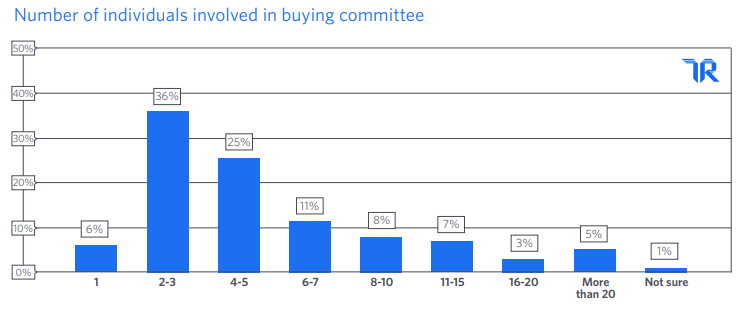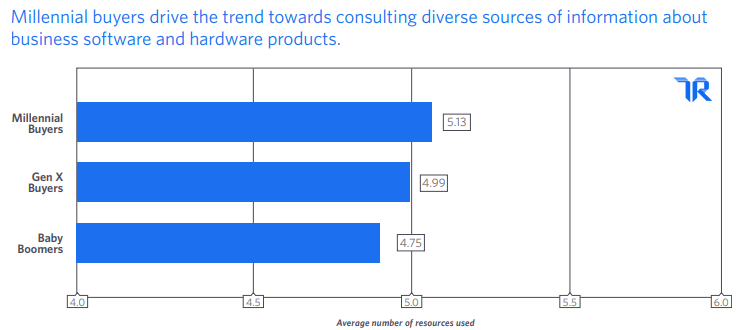New Benchmarks: How B2B Buyers Like You Purchase Software
This week, TrustRadius published The 2020 B2B Buying Disconnect Report. It provides an outlook for buying and selling business software and hardware in 2020, based on a broad survey of buyers and vendors.
The report tracks year over year trends and changes in the market. It also explores new areas of inquiry, including purchase dynamics within different organizations, the specific impact of reviews in the buyer’s journey, attitudes towards analyst rankings & reports, and how lead handling processes affect relationships.
In this post, we’ll highlight some of the key resources software buyers are using to make a purchasing decision. Buyers identified reviews, product demos, and analyst rankings or reports as being some of the most helpful resources to consult. We hope that the insights shared by other buyers are useful to you on your buyer’s journey, and help make some of the obstacles you may encounter seem less arduous.
Who’s doing the buying?
Our research uncovered that 95% of buyers work with a group of stakeholders to identify a new tool for their organization to utilize. Buying committees allow for chosen software to represent a more diverse array of interests and alleviates some of the stress associated with having a single decision-maker purchase a solution for an entire organization. Many buyers find that not going it alone leads to a more successful purchase process.

Currently, 3 out of 5 software buyers are millennials (ages 23 to 38). Millennials value collaboration and consulting more diverse sources of information. With millennials in the mix, buying committees now consult more resources before making a purchasing decision than ever. Millennials value insight from reviews, product demos, and free trials more than older buyers. However, they use vendor/product websites, vendor reps, and analyst rankings & reports less than older buyers.
Having your committee represent different groups, especially across departments if applicable, can help identify knowledge gaps, and uncover information that you may miss by sticking to only one source, like marketing content directly from a vendor.

The power of reviews
Reviews are the #1 way buyers can get unbiased information before they talk to vendors—or after, to check up on vendor claims. The most important factor when evaluating a business technology product on a review site is the review content (qualitative feedback). 39% of buyers said this was the key to their evaluations.
When analyzing reviews of a product you’re interested in, look for balanced feedback, reviewer experience and background (are they in the same industry as you? similar use case?), and reputation of the review site. More recent reviews and identifiable reviews are the best, as it lends authenticity to what you are reading. Look at reviews as helpfully coming from your peers, guiding you to make the best decision for your team and company.
“I look for independent review sites. Reviews that provide constructive feedback not simply complaints about generic issues – i.e. didn’t return my call right away, etc.”
— Cloudlock buyer spending $11k-50k
“The more specific and detailed a review is, the more likely I am to trust it. I look for reviews that are completely impartial (e.g. they haven’t received the product for free in exchange for a review) and reviews from companies similar to mine are especially helpful.”
— Adobe buyer spending $11k-50k
“I look for a review that is a good length and doesn’t lean too hard one way or another. If someone had one bad experience I generally ignore it – unless multiple people complain about the same issue. On the site I look that companies can’t pay to have their reviews removed.”
— Cision buyer spending $11k-50k
“Often, the most helpful reviews are specific use-cases that more closely match my use-case. Beyond that, more information (read: lengthy) is helpful, as is specificity within the review, so I know it was based on an actual user experience, and not a “comped” review. In terms of the site itself, more reviews with lengthy content displays authenticity.”
— Google Analytics 360 buyer spending $101k-$250k
“A thorough review is what I look for. If someone has taken the time to write a review (either good or bad), I trust that review. If it’s not thorough and I can tell quickly written, I don’t put much cadence into it.”
— Cadence buyer spending $101k-$250k
Product demos are still a must
A tried and true resource for learning more about a new tool, product demos are highly trustworthy and highly influential. Today, 61% of buyers still use product demos. Demos are most successful after you’ve already reached out to a vendor, and shared information with them about your specific use cases, needs, and industry context.
Before participating in a demo, make sure that the vendor is showing you the most up-to-date version of the product in mind, without any customizations (unless of course, you’ve already requested such to meet your needs). Also, don’t let a vendor overwhelm you by inundating you with piles of information. Make sure the demo is taken step-by-step, allowing you to ask questions, and make sure that any limitations you may observe are addressed.
“I think a great product demo walks the client through the best use case scenarios of where they would interact with the product. It’s important that the client receives a pre demo survey that helps guide the vendor in providing the best examples that fits the clients needs.”
— Hive buyer spending $10k or less
“I really love when there’s a bit of discovery up front and we can share a use case or some data that the vendor then translates into a well-informed, contextual demo for us. They connect the dots for us rather than us fumble around.”
— Outreach.io buyer spending $101k-$250k
“I want to be able to take the controls and apply some actual situations that apply to my business. I want some time to really get a feel for the ins and outs of the product, including access to all of the features that a product offers.”
— ClickUp buyer spending $10k or less
Don’t throw out the analyst with the report
Analyst rankings and reports are still a popular resource for buyers. One of the biggest factors that keep buyers away from using analyst is cost. However, more and more software analysis firms are publishing free resources for buyers.
If you’re looking to work with analyst firms for your purchase process, make sure to be aware of these limitations: analyses not being specific to your use case or priorities, biased information (vendor-sponsored research), analysts with no practical experience using the software, lack of details into software functions, or analysts in general not having an expertise in the software you’re looking to purchase.
“We most often use Gartner for this. Their strengths include providing useful aggregate intelligence such as their quadrants, or industry-specific context. They are also very useful in contract negotiations. The main limitations I find are primarily around cost. In some cases as well the analyst may be too much of a generalist for certain highly technical topics and may not have sufficient context regarding the specific needs of our organization.”
— Pure Storage buyer spending $51k-$100k (edited)
“I take analysts and industry experts opinions into consideration, but usually I need to understand what the product is doing at a low level and see that it is able to deliver its promises in my environment. This has worked for us because our purchases have delivered on what the product promises.”
— Fortinet Firewalls & VPNs buyer spending $101k-$250k
“Strengths are that I trust their assessment a lot compared to other people’s review however the limitation is that you do not get the direct feedback of based on actual usage because they are likely just getting their perspective from demos. That is why getting the feedback is so critical because they provide their unbiased feedback based on their experience with the product.” – Demandbase buyer spending $51k-$100k
— Demandbase buyer spending $51k-$100k
“Strengths are unbiased viewpoints, context, broad perspective, aggregate of information. Limitations are they don’t walk in my shoes.”
— FunctionPoint buyer spending $11k-50k
Get your free copy of the 2020 B2B Buying Disconnect Report today!
For more insights, tips on leveraging this data in your buying process, or advice on what this means for your own organization’s marketing and sales strategies, download the report here.
Was this helpful?
